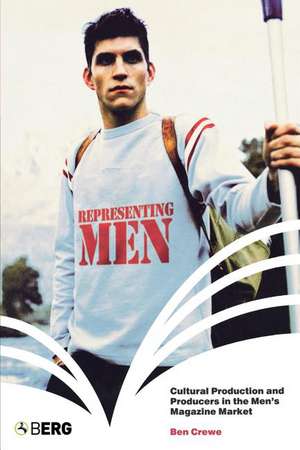Representing Men: Cultural Production and Producers in the Men's Magazine Market
Autor Ben Creween Limba Engleză Paperback – 31 oct 2003
| Toate formatele și edițiile | Preț | Express |
|---|---|---|
| Paperback (1) | 231.42 lei 6-8 săpt. | |
| Bloomsbury Publishing – 31 oct 2003 | 231.42 lei 6-8 săpt. | |
| Hardback (1) | 773.23 lei 6-8 săpt. | |
| Bloomsbury Publishing – 31 oct 2003 | 773.23 lei 6-8 săpt. |
Preț: 231.42 lei
Nou
Puncte Express: 347
Preț estimativ în valută:
44.28€ • 46.36$ • 36.64£
44.28€ • 46.36$ • 36.64£
Carte tipărită la comandă
Livrare economică 05-19 aprilie
Preluare comenzi: 021 569.72.76
Specificații
ISBN-13: 9781859737415
ISBN-10: 1859737412
Pagini: 320
Ilustrații: 10 b&w illustrations, bibliography, index
Dimensiuni: 138 x 216 x 16 mm
Greutate: 0.38 kg
Editura: Bloomsbury Publishing
Colecția Berg Publishers
Locul publicării:London, United Kingdom
ISBN-10: 1859737412
Pagini: 320
Ilustrații: 10 b&w illustrations, bibliography, index
Dimensiuni: 138 x 216 x 16 mm
Greutate: 0.38 kg
Editura: Bloomsbury Publishing
Colecția Berg Publishers
Locul publicării:London, United Kingdom
Caracteristici
Also available in hardback, 9781859737361 £55.00 (November, 2003)
Notă biografică
Ben Crewe is Research Fellow at the Institute of Criminology, University of Cambridge
Cuprins
Part IMagazines, masculinity and cultural analysis1Literature review and conceptual orientation 25Political economy and productionist paradigms 25Post-Fordism and cultural economy 30Cultural work, production and producers 36Masculinity and the new man 46The early years of the men's magazine market 54A cultural economy of the mens press 61Part IIThe structure and dynamics of the UK mens press2 The launches of the mid-1990s 64The early nineties 65The launch of loaded 72The launch of FHM 80The launch of Maxim 85The launch of Mens Health 90The new phase in the men's magazine market 93Concluding comments 973 The logic of market launches 102The institutional and economic context 104Launch origins 109Launch developments 114Attitudes towards research 118Summary and concluding comments 1224 The terms of editorial power 128 i) Publishing structures and the editor-publisher relationship 131Editing and publishing roles 131Editors, publishers and organisational structures 136 ii) The methods, dynamics and determinants of editorial production 144Assessing the reader 144Editorial capital 153Advertising imperatives and editorial conflicts, constraints and commitments 163 iii) The negotiation of editorial autonomy171Selling creativity and the company context174Market stability and editorial value179Summary and concluding comments183Part IIIEditors and magazines Introduction1875Men who should know better? The editors of loaded 190Class, education and mobility191Masculinity and heterosexuality 199Occupational identity 205loaded 216After loaded 227Concluding comments2366Editors in the mens style press239 i) Peter Howarth and Esquire240Esquire: Man at his best240Peter Howarths background and career247Masculinity and heterosexuality251Occupational identity 255Howarths Esquire260 ii) Ekow Eshun and Arena 268Ekow Eshuns background and identity268Occupational identity 273Arena: The original magazine for men276Eshuns Arena279Concluding comments286Summary and Conclusion299Appendix Research background, process and methods320Bibliography333
Recenzii
'Written in a lucid and genuinely informative style, Crewe's work will make an important contribution to the study of contemporary masculinity. Carefully nuanced [and] always attentive to contradiction - between theory and the lived practices of consumer culture, between different elements in the production process, between the editorial policies of different publications and between the social profiles of the editors.'Professor Frank Mort, University of East London'Opening up the phenomenon of the 'new lad' and his prodigious currency within magazine publishing and the wider media, Crewe offers us a detailed and compelling account of the internal dynamics of the world of 'lad publishing' and the identifications, lifestyles and motivations of its key protagonists. In doing so, he not only brings to life this media phenomenon, but also adds much to our understanding of the dynamics of commercial cultural production and the processes by which business ambition, popular desires and








